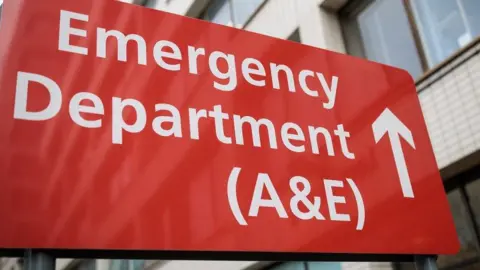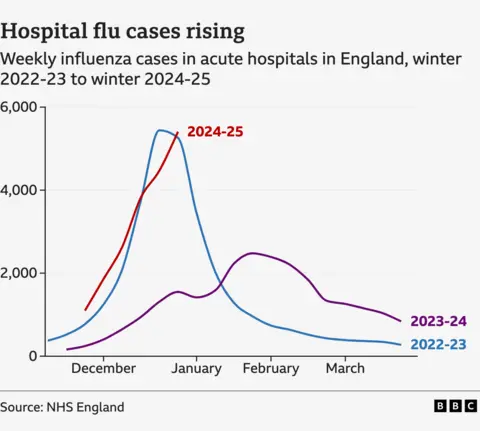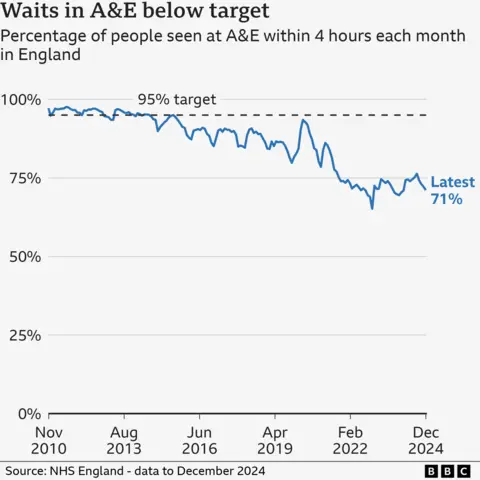
Alarm as skyrocketing flu cases add to NHS strains
 Getty Images
Getty ImagesFlu cases are skyrocketing, causing huge problems for hospitals, NHS England bosses are warning.
Last week the number of patients in hospital in England with the virus topped 5,400 a day on average – around 1,000 higher than a week before.
NHS England’s Prof Julian Redhead said cases were going up at a “concerning rate” with hospitals “bursting with patients”.
He said this was causing delays in A&E and for ambulances as staff struggled to cope with the demands being placed on them.
It comes as around 20 NHS trusts have been forced to declare critical incidents because of the pressures they are facing.
Prof Redhead, NHS England’s national director for emergency care, said the “skyrocketing” flu cases came on top of continued pressure being caused by other viruses, including Covid and the vomiting bug Norovirus.
He apologised for the problems being seen, saying staff were frustrated with the quality of care being provided under such pressures.
“I’m really proud of the way my colleagues have responded to the pressure…but nobody wants to see delays in the ambulances going out and the delays in patients getting to beds that they need. No one will be proud of that system which is occurring.”
The number of patients with flu is more than three times higher than they were this time last year – and are now on par with what was seen in early 2023 – one of the worst flu seasons for many years.

Along with the bad weather and flooding, it has meant the NHS has had a “brutal” start to the new year, according to Saffron Cordery, of NHS Providers, which represents health managers.
And she added: “We’re not out of the woods yet. Things are likely to get worse before they get better.
“Stresses and strains on emergency services are a huge concern with many patients facing long waits for ambulances and in A&Es.”
‘Like Victorian workhouse’
Liz Shearer is just one of many people who have shared their experiences with the BBC of the care being provided.
Her elderly mother spent more than 30 hours in a corridor on a hospital trolley last week because there were no bays available. She was taken to hospital after collapsing at her care home.
“I’ve never experienced anything like that in my life. It was like a Victorian workhouse. The nurses were saying how bad it is, and they were saying they just had to crack on with it.”
Yvonne Wolstenholme spent 13 hours in A&E after she was sent there by her GP because she was struggling to breathe.
“It was absolutely heaving,” she said. “Staff are snowed under, they really are rushing around like headless chickens and it’s not because of a lack of skill, it’s the lack of time to see individual patients.
“While I was there, there were at least eight ambulance crews waiting to hand over patients and obviously they are not out on the streets if they are there waiting.”

Official figures released on Thursday showed just how much the emergency care system was struggling.
- The average ambulance response time for immediately life-threatening category one calls, such as cardiac arrests, was 8 mins 40 seconds in December. The target is 7 minutes
- For category two calls, which includes heart attacks and strokes, it was 47 mins 26 seconds. The target is 18 minutes
- Just 71% of patients visiting A&E were seen and treated or admitted within the target time of four hours
But there was more positive news on routine treatment, with the hospital waiting list falling to 7.48 million at the end of November – down from 7.54 million the month before and below the record-high of 7.77 million in September 2023.
Similar pressures are being experienced in other parts of the UK with Scotland, Wales and Northern Ireland all missing their key targets.
The Royal College of Emergency Medicine in Scotland said this week hosptials there were “gridlocked” and in the middle of their own winter crisis.
Dr Tim Cooksley, of of the Society for Acute Medicine, said the NHS was experiencing an “appalling” winter crisis.
“The reality for patients and staff is corridors full of patients experiencing degrading care, being treated in the backs of ambulances because there is simply no space in hospital and the immense physical and emotional harm that inevitably results.
“The fundamental issue is that there is a continued lack of capacity throughout the year – a tough flu season must not be used as a political excuse for the current situation.”









